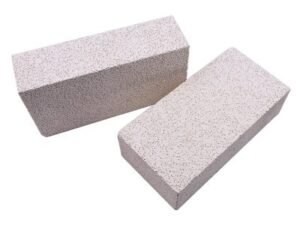How strong are lightweight mullite insulation refractory bricks? Mullite insulation bricks can not only play the role of heat insulation, mullite insulation bricks JM-23, JM-26, JM-28, JM-30 series lightweight insulation refractory bricks are a kind of insulation refractory material, which can directly contact the flame, has low thermal conductivity, low thermal melting, low impurity content, good refractoriness, fire resistance, heat resistance, good thermal shock stability, and low thermal conductivity. It plays a key role in high-temperature shuttle kilns, ceramic roller kilns and other industrial kilns, and the use of mullite lightweight insulation bricks can also help enterprises effectively save energy and reduce consumption and reduce production costs. So what kind of refractory bricks are mullite lightweight insulation bricks? What are the differences between each model?

1. Performance of lightweight mullite insulation bricks
① High temperature resistance: The main component of lightweight mullite insulation bricks is mullite, which has a melting point of up to 1850℃ and has extremely high high temperature resistance. Under high temperature conditions, the brick can maintain a stable structure and is not prone to deformation and melting.
② Anti-corrosion performance: The brick contains a large amount of mullite and has good resistance to acid and alkali erosion. It can maintain high chemical stability in various acidic and alkaline environments and extend its service life.
③ Anti-wear performance: It has a high hardness, with a Mohs hardness of 9, and has good wear resistance. It can still maintain good wear resistance under the erosion of high-speed flowing materials, reducing the number of equipment maintenance times.
④ Thermal shock stability: It has high thermal shock stability and can maintain stable performance in an environment with rapid temperature changes. It is not easy to crack or peel off during high-temperature rapid cooling, ensuring the safe operation of the equipment.
⑤ Good thermal insulation performance: Low density and good thermal insulation performance. In high-temperature equipment, the brick can effectively reduce heat loss and reduce energy consumption.
⑥ Lightweight and high strength: Lightweight mullite insulation bricks adopt a special production process to make them lightweight and high-strength. While ensuring thermal insulation performance, the bricks have high strength and can meet the needs of various high-temperature equipment.
2. Production process
The production process of lightweight mullite insulation bricks mainly includes the selection, crushing, mixing, molding and firing of raw materials.
① Raw material selection: The main raw material of the brick is mullite, and it also contains a small amount of auxiliary components such as alumina and calcium oxide. The choice of raw materials directly affects the performance and service life of bricks.
② Crushing: crush the raw materials to make them uniform in particle size, which is conducive to subsequent mixing and molding.
③ Mixing: mix the crushed raw materials, add appropriate amount of water and binder, make the various components fully combine to form a uniform mud.
④ Molding: mold the mixed mud, and use pressing, pouring and other methods to make lightweight mullite insulation bricks of different shapes and sizes.
⑤ Firing: the molded lightweight mullite insulation bricks are fired at high temperature to stabilize their structure and improve their fire resistance. The firing temperature is usually between 1400-1600℃, and the firing time depends on the thickness and size of the product.
3. Application fields
Lightweight mullite insulation bricks are widely used in various high-temperature equipment in metallurgy, chemical industry, building materials and other industries, such as ladle, iron ladle, glass kiln, cement rotary kiln, cracking furnace, tubular heating furnace, converter, hot air furnace, ladle insulation lining, shuttle kiln tunnel kiln, ceramic roller kiln, push plate kiln and other industrial furnace refractory insulation materials.
As a lining material, it can effectively protect equipment from high temperatures, acid and alkali corrosion, and material erosion, extending equipment life and reducing production costs. At the same time, its good thermal insulation properties can reduce heat loss and lower energy consumption.
4. Differences between Jm23/Jm26/Jm28/Jm30
Jm23/Jm26/Jm28/Jm30 in lightweight mullite insulation bricks represent brick numbers of different grades. Different brands have different thermal insulation properties, physical and chemical indicators, and scope of application. So what are the differences between them?
① Different Al2O3 content
The alumina contents are 38-44%, 50-58%, 60-70% and 70-73% respectively.The higher the grade, the higher the alumina content, which affects the insulation performance and refractory temperature.
② Different refractory temperatures
The refractory temperatures of the four levels of lightweight mullite bricks are 1350℃, 1430℃, 1540℃, and 1600℃ respectively. The higher the level, the higher the refractory temperature. As the alumina content increases, the refractory temperature also increases, and its stability in high temperature environments is better.
③ Different volume density
Among them, the volume density of JM23 is 0.6g/cm3, the volume density of JM26 and JM28 is the same at 0.8g/cm3, and the volume density of JM30 is 1g/cm3;
④ Different compressive strength at room temperature
The compressive strengths are 1.3Mpa, 2Mpa, 3Mpa, and 3.5Mpa respectively. The higher the compressive strength at room temperature, the greater the load-bearing capacity and service life of the bricks.
